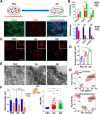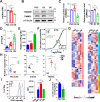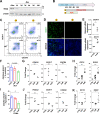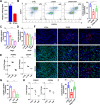Mitochondrial homeostasis regulates definitive endoderm differentiation of human pluripotent stem cells
- PMID: 35177589
- PMCID: PMC8854419
- DOI: 10.1038/s41420-022-00867-z
Mitochondrial homeostasis regulates definitive endoderm differentiation of human pluripotent stem cells
Abstract
Cellular organelles play fundamental roles in almost all cell behaviors. Mitochondria have been reported to be functionally linked to various biological processes, including reprogramming and pluripotency maintenance. However, very little about the role of mitochondria has been revealed in human early development and lineage specification. Here, we reported the characteristics and function of mitochondria during human definitive endoderm differentiation. Using a well-established differentiation system, we first investigated the change of mitochondrial morphology by comparing undifferentiated pluripotent stem cells, the intermediate mesendoderm cells, and differentiated endoderm cells, and found that mitochondria were gradually elongated and matured along differentiation. We further analyzed the expression pattern of mitochondria-related genes by RNA-seq, indicating that mitochondria became active during differentiation. Supporting this notion, the production of adenosine triphosphate (ATP) and reactive oxygen species (ROS) was increased as well. Functionally, we utilized chemicals and genome editing techniques, which could interfere with mitochondrial homeostasis, to determine the role of mitochondria in human endoderm differentiation. Treatment with mitochondrial inhibitors, or genetic depletion of mitochondrial transcription factor A (TFAM), significantly reduced the differentiation efficiency of definitive endoderm. In addition, the defect in endoderm differentiation due to dysfunctional mitochondria could be restored to some extent by the addition of ATP. Moreover, the clearance of excessive ROS due to dysfunctional mitochondria by N-acetylcysteine (NAC) improved the differentiation as well. We further found that ATP and NAC could partially replace the growth factor activin A for definitive endoderm differentiation. Our study illustrates the essential role of mitochondria during human endoderm differentiation through providing ATP and regulating ROS levels, which may provide new insight for metabolic regulation of cell fate determination.
© 2022. The Author(s).
Conflict of interest statement
The authors declare that the research was conducted in the absence of any commercial or financial relationships that could be construed as a potential conflict of interest.
Figures






Similar articles
-
Single-cell RNA-seq reveals novel regulators of human embryonic stem cell differentiation to definitive endoderm.Genome Biol. 2016 Aug 17;17(1):173. doi: 10.1186/s13059-016-1033-x. Genome Biol. 2016. PMID: 27534536 Free PMC article.
-
TGFβ-dependent mitochondrial biogenesis is activated during definitive endoderm differentiation.In Vitro Cell Dev Biol Anim. 2020 May;56(5):378-385. doi: 10.1007/s11626-020-00442-9. Epub 2020 Jun 8. In Vitro Cell Dev Biol Anim. 2020. PMID: 32514718
-
Differentiation of induced pluripotent stem cells into definitive endoderm on Activin A-functionalized gradient surfaces.J Biotechnol. 2021 Jan 10;325:173-178. doi: 10.1016/j.jbiotec.2020.10.030. Epub 2020 Nov 2. J Biotechnol. 2021. PMID: 33147515
-
The Role of Long Non-Coding RNAs in Human Endoderm Differentiation.Noncoding RNA. 2025 Apr 13;11(2):29. doi: 10.3390/ncrna11020029. Noncoding RNA. 2025. PMID: 40278506 Free PMC article. Review.
-
Mitochondria and pluripotent stem cells function.Yi Chuan. 2016 Jul 20;38(7):603-611. doi: 10.16288/j.yczz.16-001. Yi Chuan. 2016. PMID: 27733333 Review.
Cited by
-
Metabolic switching, growth kinetics and cell yields in the scalable manufacture of stem cell-derived insulin-producing cells.Stem Cell Res Ther. 2024 Jan 2;15(1):1. doi: 10.1186/s13287-023-03574-3. Stem Cell Res Ther. 2024. PMID: 38167219 Free PMC article.
-
Mitochondrial regulation in human pluripotent stem cells during reprogramming and β cell differentiation.Front Endocrinol (Lausanne). 2023 Oct 20;14:1236472. doi: 10.3389/fendo.2023.1236472. eCollection 2023. Front Endocrinol (Lausanne). 2023. PMID: 37929027 Free PMC article. Review.
-
The multifaceted role of mitochondria in cardiac function: insights and approaches.Cell Commun Signal. 2024 Oct 29;22(1):525. doi: 10.1186/s12964-024-01899-x. Cell Commun Signal. 2024. PMID: 39472951 Free PMC article. Review.
-
Stepwise differentiation of functional pancreatic β cells from human pluripotent stem cells.Cell Regen. 2022 Aug 1;11(1):24. doi: 10.1186/s13619-022-00125-8. Cell Regen. 2022. PMID: 35909206 Free PMC article. Review.
-
Low concentrations of saracatinib promote definitive endoderm differentiation through inhibition of FAK-YAP signaling axis.Cell Commun Signal. 2024 May 30;22(1):300. doi: 10.1186/s12964-024-01679-7. Cell Commun Signal. 2024. PMID: 38816763 Free PMC article.
References
-
- Khacho M, Harris R, Slack RS. Mitochondria as central regulators of neural stem cell fate and cognitive function. Nat Rev Neurosci. 2019;20:34–48. - PubMed
-
- Sun X, St John JC. The role of the mtDNA set point in differentiation, development and tumorigenesis. Biochem J. 2016;473:2955–71. - PubMed
-
- Gaspar JA, Doss MX, Hengstler JG, Cadenas C, Hescheler J, Sachinidis A. Unique metabolic features of stem cells, cardiomyocytes, and their progenitors. Circ Res. 2014;114:1346–60. - PubMed
Grants and funding
LinkOut - more resources
Full Text Sources
Other Literature Sources
Molecular Biology Databases

